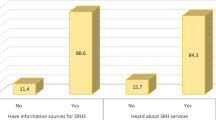Abstract
Background
Reproductive health and sexually transmitted diseases (STD) account for a high proportion of health problems in the rural-to-urban young female migrant workers in China. Improving these conditions remains highly challenging.
Purpose
To developed an educational programme to advance the reproductive health of the female workers.
Method
An intervention study was conducted between July 2010 and April 2011 in Shenzhen. Two commune factories were selected to participate and provided a control cluster receiving routine local government health services and a second cluster receiving an educational intervention in addition to the routine services. The intervention included distribution and free access to educational study materials. The factory workers’ knowledge, attitudes and behaviour in the area of reproductive health and STD were the main study outcomes.
Results
Compared with the control cluster, at the 6-month follow-up assessment, the intervention cluster had a significantly higher proportion of correct answers to queries about human immunodeficiency virus/acquired immunodeficiency syndrome (HIV/AIDS) (standardised coefficients of multiple linear regression (B) 0.047; P = 0.020) and awareness of places providing free contraceptives (odds ratio [OR] 2.011, 95 % confidence interval [CI] 1.635–2.472; P < 0.001), and a significantly lower proportion accepting premarital sex (OR 0.492, 95 % CI 0.416–0.582; P < 0.001), practising premarital sex (OR 0.539, 95 % CI 0.478–0.608; P < 0.001) or suffering from gynaecological disorders (OR 0.801, 95 % CI 0.697–0.921; P = 0.002).
Conclusion
A community-based educational intervention targeting unmarried female migrant workers appears to be effective in substantially improving their knowledge of reproductive health and their attitudes and behaviour towards health, and in reducing prevalence of STD.

Similar content being viewed by others
References
UNFPA. Improving reproductive health. 2013. http://www.unfpa.org/rh/. Accessed Dec. 22, 2013.
Qian X, Tang SL, Garner P. Unintended pregnancy and induced abortion among unmarried women in China: a systematic review. BMC Health Serv Res. 2004. doi:10.1186/1472-6963-4-1.
Gong XD. STD epidemiology and control. Bull for STI Prev and Ctrl. 2011;25:9–13.
Wu SM. Status and trends of STI’s epidemic in China. Acta Med Sin. 2006;19(5):1039–41.
Zou XP. Investigation of reproductive health status and service needs among unmarried young men in Changshu. Zhonghua Nan Ke Xue. 2002;8(5):352–9.
Yin Q, Gong QP, Mao JS, Zong ZH, Yu LL, Xu P. The living conditions of floating women in Nanjing city. J Nanjing Colg Pop Pgm Mgmt. 2008;24(3):41–2.
Speizer IS, Magnani RJ, Colvin CE. The effectiveness of adolescent reproductive health interventions in developing countries: a review of the evidence. J Adolesc Health. 2003;33(5):324–48.
Hawks SR, Madanat HN, Merrill RM, Goudy MB, Miyagawa T. A cross-cultural comparison of health promoting behaviors among college students. IEJHE. 2002;5:84–92.
Madeni F, Horiuchi S, Iida M. Evaluation of a reproductive health awareness program for adolescence in urban Tanzania—a quasi-experimental pre-test post-test research. Reprod Health. 2011;8:21. doi:10.1186/1742-4755-8-21.
Al-Iryani B, Basaleem H, Al-Sakkaf K, Crutzen R, Kok G, van den Borne B. Evaluation of a school-based HIV prevention intervention among Yemeni adolescents. BMC Public Health. 2011;11:279. doi:10.1186/1471-2458-11-279.
Parwej S, Kumar R, Walia I, Aggarwal AK. Reproductive health education intervention trial. Indian J Pediatr. 2005;72(4):287–91.
de Anda D. Replication of an intensive educational intervention for youth pregnancy and STI prevention: the GIG. Child Adolesc Soc Work J. 2008;25:55–69.
Sarah ML. Make or break? 2010: a pivotal year for scaling up RH/HIV integration and accelerating progress towards MDGS 5 and 6. 2010. http://www.aidsalliance.org/includes/document/RH_REPORT.pdf. Accessed 21 Jan 2014.
Dickinson C, Attawell K, Drucea N. Progress on scaling up integrated services for sexual and reproductive health and HIV. Bull WHO. 2009;87:846–51.
Zhu CY, Wang JJ, Fu XH, Zhou ZH, Zhao J, Wang CX. Correlates of quality of life in China rural-to-urban female migrate workers. Qual Life Res. 2012;21(3):495–03.
Huedo-Medina TB, Boynton MH, Warren MR, Lacroix JM, Carey MP, Johnson BT. Efficacy of HIV prevention interventions in Latin American and Caribbean nations, 1995–2008: a meta-analysis. AIDS Behav. 2010;14:1237–51.
O’Grady MA, Wilson K, Harman JJ. Preliminary findings from a brief, peer-led safer sex intervention for college students living in residence halls. J Prim Prev. 2009;30:716–31.
Gallant M, Maticka-Tydale E. School-base HIV prevention programmes for African youth. Soc Sci Med. 2004;58:1337–51.
Paul-Ebohimhen VA, Poobalan A, van Teijlingen ER. A systematic review of school-based sexual health interventions to prevent STI/HIV in sub-Saharan Africa. BMC Public Health. 2008;8:4. doi:10.1186/1471-2458-8-4. 10.
Qian X, Smith H, Huang W, Zhang J, Huang Y, Garner P. Promoting contraceptive use among unmarried female migrants in one factory in Shanghai: a pilot workplace intervention. BMC Health Serv Res. 2007;7:17. doi:10.1186/1472-6963-7-77.
Puffer S, Torgerson DJ, Watson J. Cluster randomized controlled trials. J Eval Clin Pract. 2005;11:479–83.
Hahn S, Puffer S, Torgerson DJ, Watson J. Methodological bias in cluster randomised trials. BMC Med Res Methodol. 2005;5:10. doi:10.1186/1471-2288-5-10.
Lewis SC, Warlow CP. How to spot bias and other potential problems in randomised controlled trials. J Neurol Neurosurg Psychiatry. 2004;75:181–7.
Acknowledgments
We wish to thank Dr. Feiyue Chai of Shajing General Hospital in Shenzhen City and Dr. Xianhua Fu of Guangzhou Medical University for their kind assistance.
Informed Consent
All procedures followed were in accordance with the ethical standards of the responsible committee on human experimentation (institutional and national) and with the Helsinki Declaration of 1975, as revised in 2000. Informed consent was obtained from all patients for being included in the study.
Conflict of Interest
All authors declare that they have no conflict of interest.
Author information
Authors and Affiliations
Corresponding author
Rights and permissions
About this article
Cite this article
Zhu, C., Geng, Q., Chen, L. et al. Impact of an Educational Programme on Reproductive Health Among Young Migrant Female Workers in Shenzhen, China: an Intervention Study. Int.J. Behav. Med. 21, 710–718 (2014). https://doi.org/10.1007/s12529-014-9401-y
Published:
Issue Date:
DOI: https://doi.org/10.1007/s12529-014-9401-y



